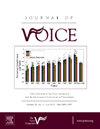Differences and Similarities in the Perception of Voice Gender for Individuals Who are or are not Members of the LGBT+ Community
IF 2.5
4区 医学
Q1 AUDIOLOGY & SPEECH-LANGUAGE PATHOLOGY
引用次数: 0
Abstract
Purpose
Compared to transgender individuals, cisgender men and women perceived “male” and “female” voices differently when using a forced-choice task with binary terms. Here, we compared individuals’ perceptions of voice gender due to the influence of their own gender and/or sexuality using a rating scale rather than a forced-choice scenario.
Methods
Fifty-five participants (cisgender, transgender, and non-binary adults) listened to vocal recordings of four cisgender men and four cisgender women speakers (some recordings were pitch shifted resulting in 12 unique voice conditions) and rated the voices on a 7-point Likert scale ranging from masculine (1) to feminine (7). Likert ratings and reaction time of responses were recorded and analyzed. For a small subset of recordings, participants provided terms to describe the gender of the recorded voices.
Results
For the Likert voice gender rating task, there was a significant effect of gender for two out of twelve conditions. There were no significant effects of sexuality on any of the conditions. For reaction time (RT), there was no significant effect of gender for any conditions. There was no significant effect for sexuality when one subject was removed (for one condition). The number of vocabulary terms used to describe gender was significantly higher for LGBT+ participants, who used significantly more descriptive terms than those who identified as cisgender and heterosexual.
Discussion
Cisgender heterosexual speech-language pathologists working with transgender/non-binary clients can be more confident that their conceptualization and perception of voice gender are likely to align with that of their clients. Clinicians should utilize continuum terms (masculine, feminine) rather than the binary terms (male, female). Training of speech-language pathologists should include increasing awareness and knowledge of the perspectives and terminology used by members of the LGBT+ community with the aim of improving future clinician-client communication.
男女同性恋、双性恋和变性者(LGBT+)群体成员对声音性别认知的异同。
目的:与变性人相比,当使用二元术语强制选择任务时,顺性别男性和女性对 "男性 "和 "女性 "声音的感知不同。在此,我们使用评分量表而不是强迫选择情景,比较了受自身性别和/或性倾向影响的个体对声音性别的感知:方法:55 名参与者(顺性别、跨性别和非二元成人)聆听了四位顺性别男性和四位顺性别女性发言人的声音录音(部分录音进行了音调转换,从而产生了 12 种独特的声音条件),并用 7 点李克特量表对声音进行评分,评分范围从男性(1)到女性(7)。我们记录并分析了李克特评分和反应时间。对于一小部分录音,参与者提供了描述录音声音性别的术语:结果:在李克特声音性别评级任务中,12 个条件中有 2 个条件的性别效应显著。在所有条件中,性别均无明显影响。在反应时间(RT)方面,性别对任何条件都没有显著影响。如果去掉一名受试者(一个条件),性别也没有明显影响。LGBT+ 参与者用于描述性别的词汇数量明显较多,他们使用的描述性词汇明显多于那些被认定为双性恋和异性恋的人:讨论:与变性/非二元客户合作的顺性别异性恋言语病理学家可以更自信地认为,他们对声音性别的概念化和感知可能与客户的一致。临床医生应使用连续术语(男性、女性),而不是二元术语(男性、女性)。言语病理学家的培训应包括提高对 LGBT+ 群体成员的观点和术语的认识和了解,以改善未来临床医生与客户之间的沟通。
本文章由计算机程序翻译,如有差异,请以英文原文为准。
求助全文
约1分钟内获得全文
求助全文
来源期刊

Journal of Voice
医学-耳鼻喉科学
CiteScore
4.00
自引率
13.60%
发文量
395
审稿时长
59 days
期刊介绍:
The Journal of Voice is widely regarded as the world''s premiere journal for voice medicine and research. This peer-reviewed publication is listed in Index Medicus and is indexed by the Institute for Scientific Information. The journal contains articles written by experts throughout the world on all topics in voice sciences, voice medicine and surgery, and speech-language pathologists'' management of voice-related problems. The journal includes clinical articles, clinical research, and laboratory research. Members of the Foundation receive the journal as a benefit of membership.
 求助内容:
求助内容: 应助结果提醒方式:
应助结果提醒方式:


